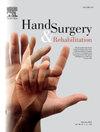成人肱神经丛外伤的临床检查与电断层扫描-诊断准确性分析
IF 0.9
4区 医学
Q4 ORTHOPEDICS
引用次数: 0
摘要
外伤性臂丛神经损伤是上臂最具破坏性的损伤之一,具有巨大的功能、心理和社会经济影响。评估包括详细的体格检查、影像学和电诊断研究。本研究的目的是确定外伤性臂丛神经损伤患者术前肌电图检查和体格检查的效果,并与术中结果进行比较。回顾了2020 ~ 2023年36例外伤性臂丛神经损伤患者的病历。最初,患者接受了详细的临床检查。然后进行常规肌电图检查。所有患者均行手术探查,术中表现具有相关性。进行统计分析,p值<;0.05认为有统计学意义。单独使用时,临床检查和常规肌电图不能定位病变部位的分别为36例中的3例和36例中的20例。手术探查对肌电图的正确率为44.44%,体格检查的正确率为91.66%。单独的肌电图预测率较低(R2 = 10.61%),而单独的临床试验如果执行得好,是非常有用的(R2 = 84.16%)。两者联合使用时,预测率没有明显变化,但仍保持在较高水平(R2 = 84.28%)。尽管人们一致认为不应仅依赖一种术前评估,而应结合临床检查、电诊断研究和影像学检查,但诊断中的问题仍在继续出现。以往的研究表明,体格检查是评估臂丛病变定位的一种非常准确的工具,并表明当电诊断研究和MRI结合使用时,诊断准确性明显提高。我们的研究表明,当肌电图和体格检查一起使用时,并不能提高诊断的准确性。我们已经证明,如果由训练有素且经验丰富的手外科医生进行肌肉测试,在大多数情况下可以正确识别病变部位,并且具有最高的预测价值。否则,当单独使用肌电图时,可预测性下降到令人惊讶的百分比。体格检查可能是评估臂丛病变最准确的工具。当肌电图和体格检查同时使用时,不能显著提高诊断的准确性。肌电图在伸展的上神经丛和全神经丛的情况下变得不可靠;因此,检测病变部位的金标准仍然是手术探查术中神经刺激。本文章由计算机程序翻译,如有差异,请以英文原文为准。
Examen clinique versus électromyographie dans les lésions traumatiques du plexus brachial chez l’adulte — Analyse de la précision diagnostique
Traumatic brachial plexus injury is one of the most devastating injuries of the upper arm, with great functional, psychological and socioeconomical impact. Evaluation includes a detailed physical examination, imagistic and electrodiagnostic studies. The purpose of this study was to determine the efficacy of preoperatory EMG examination versus physical testing of patients with traumatic brachial plexus injury when comparing with intraoperative findings.
The medical records of 36 patients with traumatic brachial plexus injury from 2020 until 2023 were reviewed. Initially the patients underwent a detailed clinical examination. Then, they were subjected to routine EMG. All of them underwent surgical exploration and the intraoperative findings were correlated. A statistical analysis was performed and P-values < 0.05 were considered statistically significant.
When used alone, clinical examination and routine EMG could not locate the site of the lesion in 3 of 36 and 20 of 36 patients, respectively. The surgical explorations have confirmed 44.44% of EMG results while the physical tests were accurate in 91.66% of cases. Moreover, the predictive rate of EMG alone is low (R2 = 10.61%), while the clinical tests alone are very useful if well performed (R2 = 84.16%). When used together, the predictive rate doesn’t modify significantly but remains at a high level (R2 = 84.28%).
Although there is a consensus that one should not rely only on one type of preoperative evaluation alone but to a combination of clinical examination, electrodiagnostic studies and imaging investigations, problems in diagnosis continue to arise. Previous studies indicate that physical examination is a very accurate tool for assessing the localisation of brachial plexus lesions and suggest that when electrodiagnostic studies and MRI are used in conjunction with it, the diagnostic accuracy is clearly improved. Our study shows that when used together, EMG and physical examination together don’t improve diagnostic accuracy. We have proven that muscle testing, if it is performed by a trained and experienced hand surgeon, can correctly identify the site of the lesion in most of cases and has the highest predictive value. Otherwise, when using EMG alone, the predictability drops to a surprising percentage.
Physical examination is probably the most accurate tool for assessing brachial plexus lesions. When used together, EMG and physical examination together don’t significantly improve diagnostic accuracy. The EMG becomes less reliable in cases of extended upper plexus and total plexus; therefore, the gold standard in detecting the site of the lesions remains surgical exploration with intraoperative neurostimulation.
求助全文
通过发布文献求助,成功后即可免费获取论文全文。
去求助
来源期刊

Hand Surgery & Rehabilitation
Medicine-Surgery
CiteScore
1.70
自引率
27.30%
发文量
0
审稿时长
49 days
期刊介绍:
As the official publication of the French, Belgian and Swiss Societies for Surgery of the Hand, as well as of the French Society of Rehabilitation of the Hand & Upper Limb, ''Hand Surgery and Rehabilitation'' - formerly named "Chirurgie de la Main" - publishes original articles, literature reviews, technical notes, and clinical cases. It is indexed in the main international databases (including Medline). Initially a platform for French-speaking hand surgeons, the journal will now publish its articles in English to disseminate its author''s scientific findings more widely. The journal also includes a biannual supplement in French, the monograph of the French Society for Surgery of the Hand, where comprehensive reviews in the fields of hand, peripheral nerve and upper limb surgery are presented.
Organe officiel de la Société française de chirurgie de la main, de la Société française de Rééducation de la main (SFRM-GEMMSOR), de la Société suisse de chirurgie de la main et du Belgian Hand Group, indexée dans les grandes bases de données internationales (Medline, Embase, Pascal, Scopus), Hand Surgery and Rehabilitation - anciennement titrée Chirurgie de la main - publie des articles originaux, des revues de la littérature, des notes techniques, des cas clinique. Initialement plateforme d''expression francophone de la spécialité, la revue s''oriente désormais vers l''anglais pour devenir une référence scientifique et de formation de la spécialité en France et en Europe. Avec 6 publications en anglais par an, la revue comprend également un supplément biannuel, la monographie du GEM, où sont présentées en français, des mises au point complètes dans les domaines de la chirurgie de la main, des nerfs périphériques et du membre supérieur.
 求助内容:
求助内容: 应助结果提醒方式:
应助结果提醒方式:


